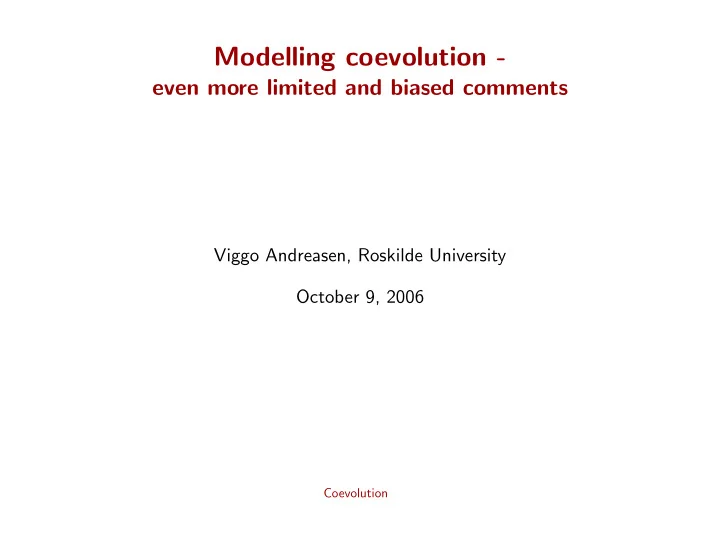

Modelling coevolution - even more limited and biased comments Viggo Andreasen, Roskilde University October 9, 2006 Coevolution
Problems in modelling coevolution • Meaning of the term • Does coevolution occur? • Modelling diploid (host) genetics Coevolution 1/4
What is coevolution • First used by Ehrlich and Raven (1964). Butterflies and plants: a study in coevolution. Evolution 18: 586. • Roughgarden(1976) defines Coevolution as ”evolution in which the fitness of each genotype depends on the population densities and genetic composition of the species itself and the species with which it interacts” (TPB 9:388) • Janzen (1980) requires that ”each of two and more species change in genetic composition in response to a genetic change in the other.” (Am Nat 104: 501) Cited after D J Futuyma: Evolutionary Biology Coevolution 2/4
Diploids - Discrete generations • Non-overlapping generations • One locus - two Alleles A and B • Random mating p frequency of A. q = 1 − p freq of B . w i probability of surviving season for genotype i = AA, AB, BB (Darwinian) Fitness w AA p 2 + w AB pq p ′ = w AA p 2 + w AB 2 pq + w BB q 2 Use final size of (closed) epidemic to determine w i (Gillespie, 1975) Coevolution 3/4
Diploids - Overlapping generations • Continuous time • One locus - two Alleles A and B • Random mating among ALL hosts p = (2 N AA + N AB ) /N frequency of A. ˙ N AA = bp 2 N − ( µ + ǫµ AA ) N AA For ǫ ≪ 1 population converges to HW proportions and p = − ǫp ( µ AA p + µ AB q − µ ) ˙ with µ = µ AA p 2 + µ AB 2 pq + µ BB q 2 . (Malthusian) fitness − µ i may depend on disease in complicated way. Coevolution 4/4
Recommend
More recommend